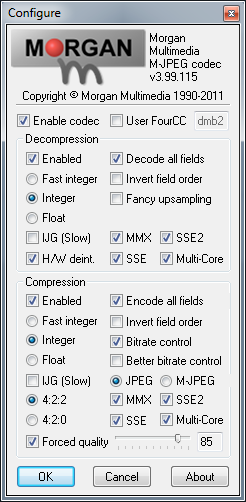M-JPEG codec Configuration
Configuration options
Section about the codec (compressor/decompressor)
- Enable codec : Enable/Disable the codec.
- User FourCC : Enable/Disable User defined FourCC.
Section about the decompressor
- Enabled : Enable/Disable the decompressor.
- Fast integer / Integer / Float : Precision used for DCT processing.
- MMX : Allow the use of MMX instruction set (valid only if MMX is detected)
- SSE : Allow the use of SSE instruction set (valid only if SSE is detected)
- SSE2 : Allow the use of SSE2 instruction set (valid only if SSE2 is detected)
- Multi-Core : Enable/Disable use of the multi-threaded optimized mode. If enabled, decompress the first field with the first CPU core while decompressing the second field with the second CPU core (valid only if a Multi-Core or Multi-CPU system is detected). Specific to DirectShow playback (using Windows Media Player for instance), can decode n frames on n CPU cores concurently.
- Decode all fields : If enabled, decompress and display 2 interleaced fields per frame.If disabled, decompress and display only 1 field per frame. (Frame height need to be more than 288)
- Invert field order : Odd lines become even lines and even lines becomes odd lines. (Frame height need to be more than 288, SupportInterleave need to be set)
- Fancy upsampling : If enabled, do careful upsampling of chroma components. If disabled, a faster but sloppier method is used. The visual impact of the sloppier method is very very small.
- IJG (Slow) : Enable/Disable the decompressor IJG core. It is the IJG based optimized V1 core and is there for compatibility purpose only. If the new V3 core fails to play an "exotic" M-JPEG stream, it tries to use the IJG core. If enabled, force the use of V1 core instead V3 core. (IJG : Independent JPEG Group).
- H/W deint. : Enable/Disable hardware deinterlacer to be used (only for DirectShow).
Section about the compressor
- Enabled : Enable/Disable the compressor.
- Fast integer / Integer / Float : Precision used for DCT processing
- MMX : Allow the use of MMX instruction set (valid only if MMX is detected)
- SSE : Allow the use of SSE instruction set (valid only if SSE is detected)
- SSE2 : Allow the use of SSE2 instruction set (valid only if SSE2 is detected)
- Multi-core : Enable/Disable use of the multi-threaded optimized mode. If enabled, compress the first field with the first CPU core while compressing the second field with the second CPU core (valid only if a Multi-Core or Multi-CPU system is detected).
- Encode all fields : If enabled, compress 2 fields per frame (2 JPEG images are stored, one per field, for each frame).If disabled compress and store only the first field. (Frame height need to be more than 288)
- Invert field order : Odd lines become even lines and even lines becomes odd lines. (Frame height need to be more than 288, SupportInterleave need to be set).
- IJG (Slow) : Enable/Disable the decompressor IJG core. It is the IJG based optimized V1 core and is there for compatibility purpose only. If enabled, force the use of V1 core instead V3 core. (IJG : Independent JPEG Group).
- 4:2:2 / 4:2:0 : Define the subsampling mode to be used.
- Bitrate control : Enable/Disable data rate checking. If disabled, ignore the dwFrameSize parameter of ICCompres function, only uses dwQuality parameter. Enable/Disable strong data rate checking (CheckDataRate need to be enabled)
- Better bitrate control : If enabled, perform a more accurate but slower data rate checking.
- JPEG / M-JPEG : If JPEG is selected, do progressive encoding (1 JPEG image per frame). If M-JPEG is selected, do interlaced encoding (2 JPEG images per frame) if height is more than 288 (conforms to M-JPEG AVI specifications).
- Forced quality : Enable/Disable forced quality. If enabled, ignore the dwFrameSize and thedwQuality parameters of ICCompres function, uses ForcedQualityValue instead. Define forced quality. (ForcedQuality need to be enabled to use this setting).
What is JPEG2000 ?
JPEG2000 is the new international standard for image compression method and file format. This is the successor of the well-known traditional JPEG written by the ISO group Joint Photographic Experts Group.
Contrary to the technology JPEG which used DCT functions, JPEG2000 technology is based on an mathematical algorithm called wavelets to compress image that provides high compression with image quality superior to all existing standard encoding techniques even at low bit rates.
That’s the reason why JPEG2000 has a number of advantages over the JPEG Format.

JPEG2000 Advantages vs. JPEG ?
- Higher compression without compromising quality.
- Progressive image reconstruction which allows to see full image even during the transmission process.
- Define Region of interest that allows to define some important areas to be compressed at a higher quality than other one.
- Lossy and lossless compression: have the choice of loosing quality but having little files or preserve all the quality but still saving a lot of space.
- Error resilience functionality for noisy channels allows the transmission of JPEG 2000 images in mobile applications.
- No artifact with very high compression.
- The JP2 file format (.jp2) is XML based metadata.
- Easier random access to code stream for reorganization of data while transmission process.

JPEG2000 Application domains ?
JPEG2000 is the new image encoding standard that provides essential features to many emerging imaging applications. Its features make JPEG2000 an excellent solution for :
- Internet video and imaging and zoom image applications
- Mobile applications such as mobile phone or PDA.
- CD-Rom video distribution
- Distance learning
- Videoconferencing
- Video capture systems
- Surveillance and secure systems
- Medical imaging
- Scanners
- Digital Cameras and photography
- Satellite imagery
- Document and image storage
- Digital Cinema
- Digital long term preservation






